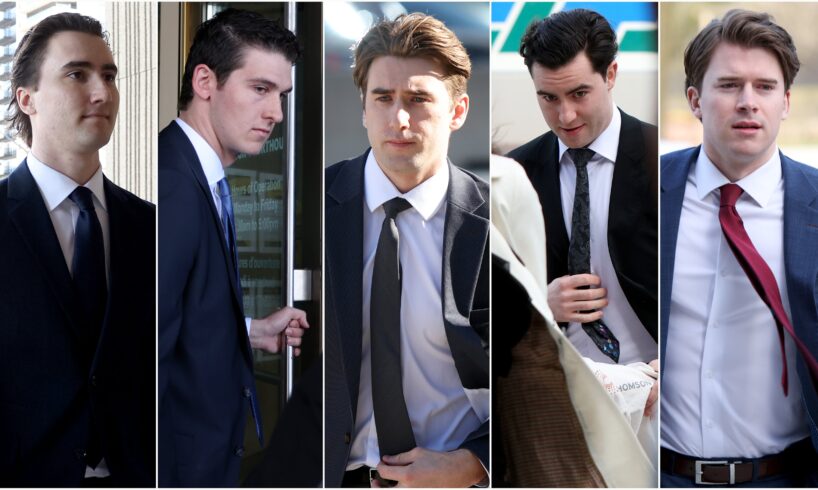
Open this photo in gallery:
From left to right: Alex Formenton, Cal Foote, Michael McLeod, Dillon Dube and Carter Hart arrive at a court in London, Ont., in late April. The trial of the five hockey players has given a rare national profile to how the criminal-justice system addresses sexual assault.Nicole Osborne/The Canadian Press
A verdict this week in the prosecution of five hockey players on sexual-assault charges could break new ground on the question of what constitutes voluntary consent, in cases of an apparent power imbalance – in this instance, multiple men in a hotel room with an intoxicated woman most of them had never met.
The trial, which heard closing submissions last month, has given a rare national profile to how the criminal-justice system addresses sexual assault. The trial’s many unusual elements, including seven days of cross-examination of the complainant, and allegations against five young men from Canada’s 2018 gold medal-winning world junior team, have combined to give this case a broad importance in social and legal terms.
Front and centre is the issue of consent.
It has long been established in Canadian law that consent is not just the absence of a “no.” Consent requires an affirmation – a yes, in words or conduct. But what about when there is a yes, in circumstances in which an individual might not see a way out?
Opinion: The criminal justice system keeps failing sexual-assault survivors. There has to be a better way
At the heart of the decision facing Ontario Superior Court Justice Maria Carroccia is whether E.M., the complainant in the case whose name is protected by a publication ban, communicated to the five men at the time of sexual activity with each of them that she was voluntarily consenting. In part, that rests on the judge’s assessment of the facts, such as whether E.M. was requesting sex at various times, as the court heard during the trial in London, Ont.
But then the judge must decide whether E.M. was just “going along to get along,” said Toronto lawyer David Butt, who was not involved in the case. And if so, did she induce an honest belief in the men, even if a mistaken one, that she was consenting?
That defence – known as honest but mistaken belief – has been diminishing over the past several years, as a result of legislative changes and court precedents, said Janine Benedet, who teaches at the University of British Columbia’s Peter A. Allard School of Law.
“This case may be a really important one for addressing the idea that in circumstances where you’re not sure whether a person is truly, voluntarily consenting. You don’t know them, you don’t even know their name and there’s all these men in the room demanding these sexual acts – how can you say that you honestly believed that voluntary consent had been communicated to you?” she said. “And how can you say you took reasonable steps?”
In some cases, Prof. Benedet said, “reasonable steps may mean that you don’t do it. That would be a really important statement for the law to make. That would be an advance and an important affirmation that reasonable steps aren’t just, ‘Well, that was the most I could be expected to do in the circumstances.’ Sometimes reasonable steps mean that you stop – and some of them did.”
A similar issue may arise with what have become known as consent videos, taken of the complainant in the hotel room after the sexual activity, in which she said it was consensual.
“If the circumstances around the alleged sexual assault were intimidating, the consent video might also be made in intimidating circumstances, which would undermine its value,” Lisa Dufraimont, who teaches at York University’s Osgoode Hall Law School, said.
Michael McLeod, Dillon Dubé, Carter Hart, Cal Foote and Alex Formenton were charged with sexually assaulting a woman, known in court as E.M. to protect her identity, in a hotel room after a Hockey Canada gala in June, 2018. Mr. McLeod faced a second charge of being a party to sexual assault. All pleaded not guilty. The men ranged in age from 18 to 20 at the time; E.M. was 20.
Open this photo in gallery:
Mr. Formenton arrives at a courthouse in London, Ont., during the trial in early May.Geoff Robins/The Canadian Press
It was only in 1982 that the Criminal Code was updated to say no consent exists where an individual submits or does not resist because of force or threats. Even so, judges often continued telling juries to look for “emphatic verbal or physical resistance” as evidence of non-consent, Prof. Benedet wrote in the Alberta Law Review in 2014.
So in 1992, the federal government defined consent in legislation for the first time – “the voluntary agreement of the complainant to engage in the sexual activity in question.” It was now clear that a yes in some form was necessary.
But not to everyone – not until an Alberta case proved to be the turning point. The complainant was a 17-year-old woman raising a six-month-old baby and looking for work. Steve Ewanchuk, after interviewing her for a job with his custom wood-working business in 1994, invited her into the trailer of his vehicle to see his work. He then closed the door, massaged her until she said no, got on top of her until she said no and placed his naked penis on her pelvis – again she said no. She feared that if she resisted too strenuously, or showed her fear, things would go badly for her.
At Mr. Ewanchuk’s sexual-assault trial in the mid-1990s, the judge said that because she had not communicated her fear, the accused man had no way of knowing she had not consented; her consent was therefore “implied.” The judge swept aside her repeated no’s, made no mention of the 1992 law requiring an affirmative consent and acquitted Mr. Ewanchuk. When the Crown appealed, a judge on Alberta’s highest court wrote in 1998 that the complainant had not gone into the man’s trailer “in a bonnet and crinolines.” In other words, she had asked for it. Mr. Ewanchuk was acquitted again, on a 2-1 count.
But the dissenting judge, then-chief justice Catherine Fraser, made a comment that reflects the state of the law today.
“Women in Canada are not walking around this country in a state of constant consent to sexual activity unless and until they say ‘No’ or offer resistance to anyone who targets them for sexual activity,” she wrote. There is no such thing as implied consent in the sense that the lower-court judge meant it, she said.
The Supreme Court later agreed in an unanimous decision that convicted Mr. Ewanchuk – a ruling that established that participants in sexual activity must take “reasonable steps” to ascertain consent.
But if there was an onus on the accused hockey players to take reasonable steps, there is also an obligation on the Crown to prove the lack of consent beyond a reasonable doubt.
Judge in Hockey Canada case – set to deliver verdict next week – is a veteran of the criminal courts
Reasonable doubt “is a Crown’s nightmare,” says Mr. Butt, who represents sexual-assault complainants and accused people. He explains reasonable doubt to his complainant-clients this way: If there’s an 85 per cent chance of rain, only a fool wouldn’t take an umbrella. But if there’s only an 85 per cent likelihood that an accused person is guilty as charged, they must be acquitted.
“It’s such a high standard of certainty,” he said.
A judge may find that a complainant is telling the truth, but still find the accused telling a plausible version of events, enough to raise a reasonable doubt.
Even if a judge decides that an accused is probably guilty, “the accused must be acquitted if his version of events raises a reasonable doubt about guilt,” Prof. Dufraimont said.
Delay can make a reasonable doubt more likely. The hockey players’ trial began seven years after the alleged assaults, in part because of an initial police investigation with gaps. As memories wane, delay may make it harder to establish with a high degree of certainty what happened in a given case.
And while #MeToo has raised the profile of sexual-assault issues, judges must still assess the accuracy and honesty of a complainant’s testimony.
Open this photo in gallery:
A courtroom sketch of Crown Meaghan Cunningham and Justice Maria Carroccia during the trial in May.Alexandra Newbould/The Canadian Press
Given its high profile, the trial of the hockey players has taken on a social importance, perhaps for young people in particular.
“This case is presenting people with the opportunity to think about how the legal definition of consent might be different and in fact more robust than what they imagine from movies or TV or wherever they’re getting their information from,” Prof. Benedet said.
To her, the case raises questions about the “entitlement” some young men feel to the body of an intoxicated woman. “It’s good that we’re at least talking about these questions.”
One frequent point of discussion: the seven gruelling days that E.M., the complainant, spent under cross-examination from five defence teams.
“Does that really help us get at the truth,” Allard law professor Isabel Grant asked of the seven days, “or does it just wear complainants down and send a message to other potential complainants to think again before coming forward?” She suggested limits could have been placed on the cross-examination.
But to some participants in the criminal-justice process, the long and vigorous cross-examination was intended to get at the truth of the events.
“Yes, that may seem a little oppressive,” said criminal-defence lawyer Joseph Neuberger, who was not involved in the case, “but that is our system. Trials are uncomfortable – it’s not meant to be otherwise.”
The trial has also drawn attention to what some see as the continued use of myths and stereotypes in a sexual-assault trial. Over the past decades, the courts have forbidden use of the “twin myths” – that a sexually active complainant is more likely to have consented, and less likely to be telling the truth. But some observers felt other stereotypes cropped up in the hockey players’ trial.
Prof. Benedet said the complainant was portrayed by some defence counsel as being desperate for the attention of the young men. That, and the idea that her intoxication (she’d had about eight drinks at a bar that night) made her become a different kind of person, are “damaging, discredited stereotypes I would have hoped we would have discarded.”
Mr. Neuberger said that stereotypes can be damaging to male accused as well.
“Nothing defines people more than their willingness to do irrational things, especially when alcohol is involved. People do not act in any pre-conceived way and myth-based reasoning about how men and women behave in sex assault trials must be avoided.”
In light of the difficulties of the process, including the dismissal of two juries, can justice be done for the complainant and the accused in this case? A trial by a jury is a right of the accused, and after the second dismissal, it will be Justice Carroccia rendering the verdict.
“I think the trial was fair,” Prof. Dufraimont said. “The accused all had excellent legal representation. There was extensive evidence from a number of witnesses that will help the judge determine what happened and reach an appropriate verdict.”
Some worry, though, that putting complainants through such an arduous experience could discourage others from coming forward.
“The message I’m guessing to a lot of people who have experienced sexual violence: ‘That game is not worth the candle,’” Mr. Butt said.
He would like to see alternatives to a criminal trial for sexual offences be made available, in appropriate cases. Alberta has a pilot project for restorative justice that allows for complainants and abusers to be brought together, if the abusers accept responsibility for the harm they caused. (Ultimate control over sentencing or outcome still rests with the judge in Alberta.)
Not everyone agrees.
“I’m not ready to throw up my hands and simply walk away from the criminal justice system” said Prof. Benedet.
Mr. Neuberger fears that, if the hockey players are acquitted, the federal government will introduce disastrous legislative reforms – whether affecting the use of consent videos or the definition of consent itself.
Prof. Grant is concerned that the “spectacle” of the trial, including the “brutal” cross-examination, may deter others from coming forward, and acquittals would discourage reporting to police even more.
“Everyone working in the field of sexual assault is very worried about the impact of acquittals in this case.”
Mr. Butt says he tells his complainant-clients that part of his job is to prepare them for disappointment. The ones who stick with it, he says, are not investing their well-being in a particular outcome, recognizing the court process unfolds in ways unrelated to their own validation.
His clients tell him: “’What’s important to me is to stand up publicly and state what happened to me. I just have to speak my truth in front of the person who did this to me, and what the court does with it, the court does with it.’”
Special to The Globe and Mail





